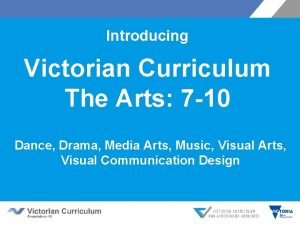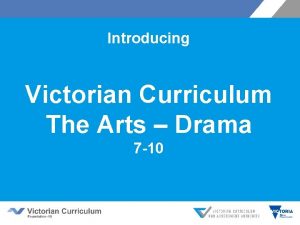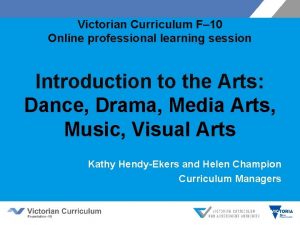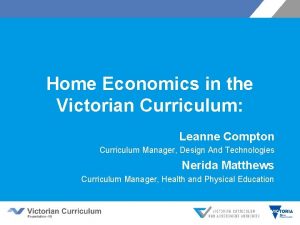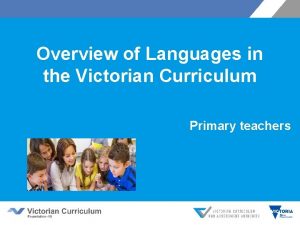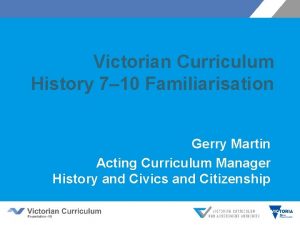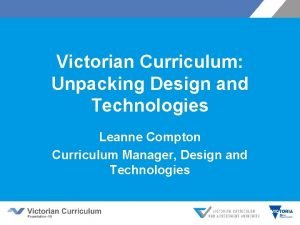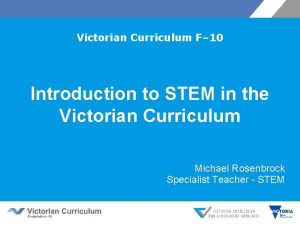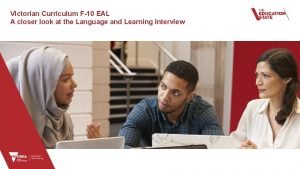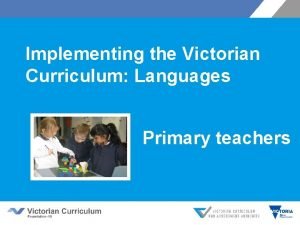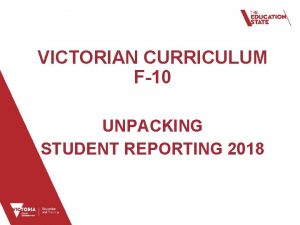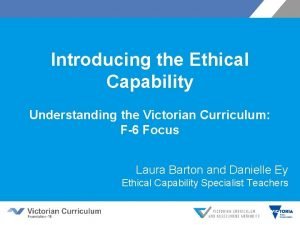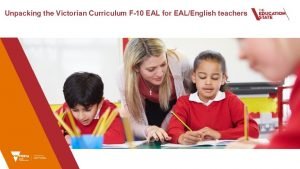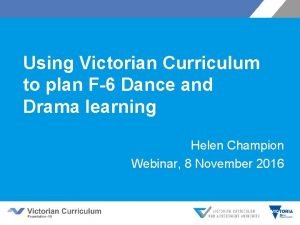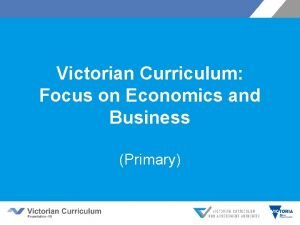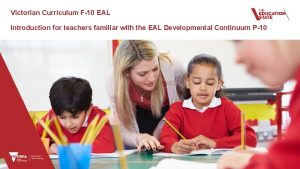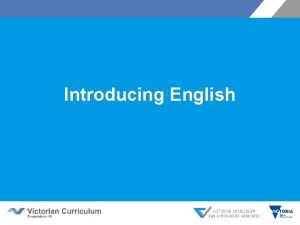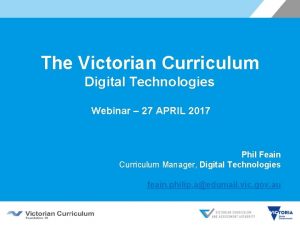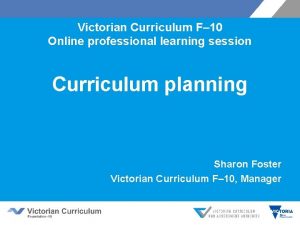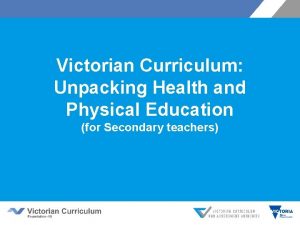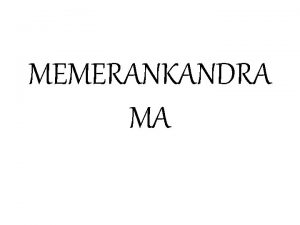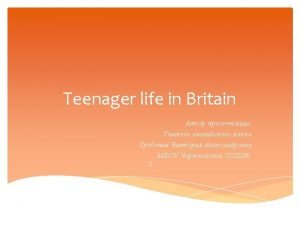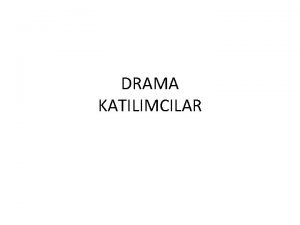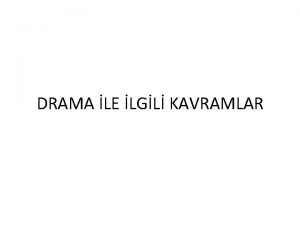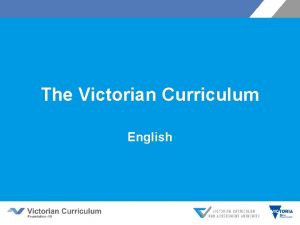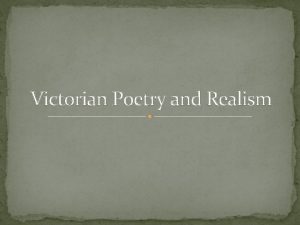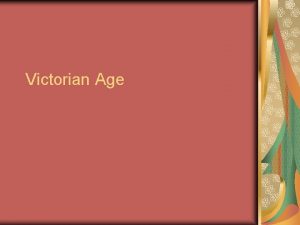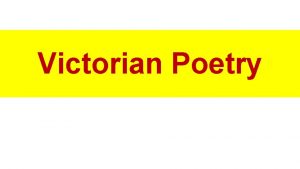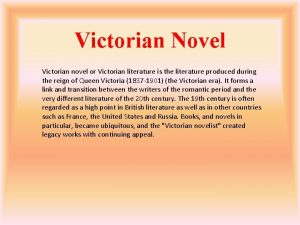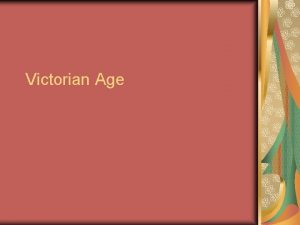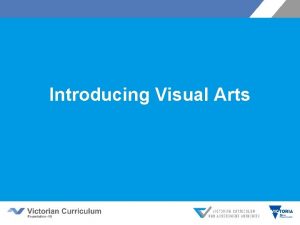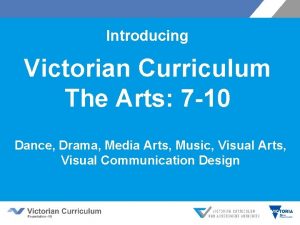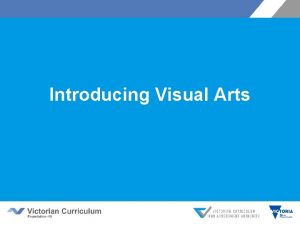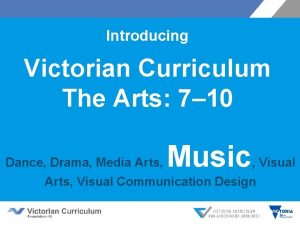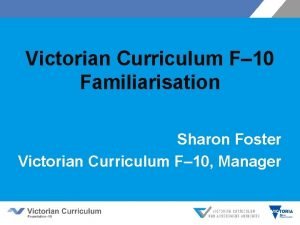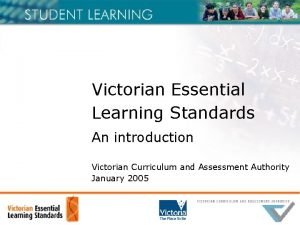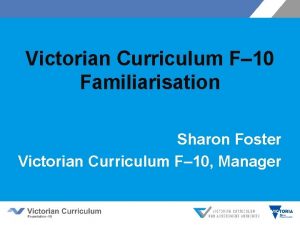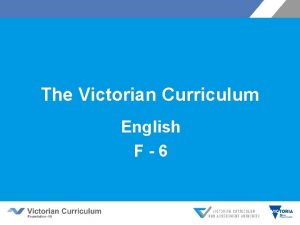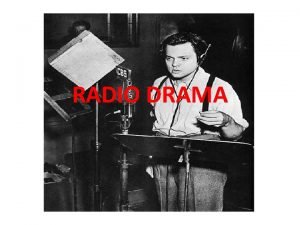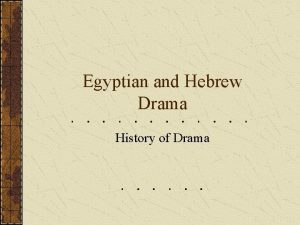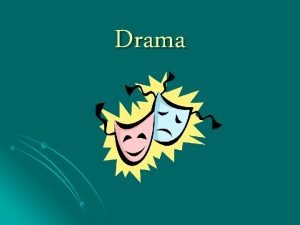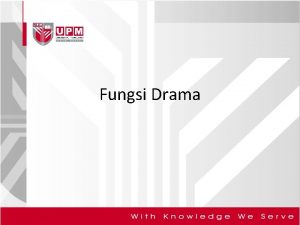Introducing Victorian Curriculum The Arts Drama 7 10

































- Slides: 33

Introducing Victorian Curriculum The Arts – Drama 7 -10

Session overview • The Arts and Drama in the Victorian Curriculum • • Learning area, strand, content description, achievement standard, elaboration Working with the curriculum • Drama overview: • • • Devising, scripting, presenting and performing, improvising, games … Making and Responding Artist and Audience • Curriculum planning for Drama learning • • • 2016 – a year of transition Planning resources and templates Partnerships, incursions, excursions and residencies

Victorian Curriculum F– 10 • Released in September 2015 as a central component of the Education State • Provides a stable foundation for the development and implementation of whole-school teaching and learning programs • Victorian Curriculum F– 10 incorporates the Australian Curriculum and reflects Victorian priorities and standards

Learning areas & Capabilities Learning Areas Victorian Curriculum F-10 is represented as a continuum of learning The Arts • Dance • Drama • Media Arts • Music • Visual Arts • Visual Communication Design English Health and Physical Education The Humanities • History • Geography • Civics and Citizenship • Business and Economics Languages Mathematics Science Technologies • Design and Technologies • Digital Technologies Capabilities Critical and Creative Thinking Ethical Intercultural Personal and Social

The Arts in the Victorian Curriculum 1 Learning Area with curriculum for six Arts disciplines: F-10 • Dance, • Drama, • Media Arts, • Music, • Visual Arts 7 -10 • Visual Communication Design

Victorian Curriculum: The Arts 4 +2 Strands: • • explore & express/represent ideas practices present & perform respond & interpret Organising ideas: • students learn as artist and as audience • Students learn by making & responding

Levels of achievement F 1 -2 3 -4 5 -6 7 -8 9 -10 • The curriculum is represented on a continuum across 6 levels of achievement • In The Arts, an achievement standard is provided for each band • The Foundation (F) standard signifies the importance of The Arts in the early years of schooling • A curriculum to support students with a disability is provided and this is know as Towards Foundation Levels A-D

Terminology • Band/Level descriptions • statements that provide an overview to the content descriptions and achievement standard within the level or band. • Strands • key organising elements within each curriculum area. • Content descriptions • specific and discrete information identifying what teachers are expected to teach and students are expected to learn. • Elaborations • non-mandated, advisory examples that provide guidance on how the curriculum may be transformed into a classroom activity or learning opportunity. • Achievement standards • statements that describe what students are typically able to understand, and are the basis for reporting student achievement.

Strands § Explore and Express Ideas Present and Perform Practices Respond and Interpret § The curriculum for each of the Arts disciplines uses a common structure with four interdependent strands, each involving making and responding This structure provides flexibility for schools to develop learning programs that § Are continuous or noncontinuous within a single discipline § Connect across learning areas or Arts disciplines

Interdependent strands Strand Explore and Express Ideas … exploring and shaping ideas … use imagination and responses to stimulii … and drama they have viewed … Drama Practices Present and Perform Respond and Interpret … reflecting, … applying acting, questioning … skills, direction, design techniques and analysing elements and processes for as drama-maker, stagecraft in creating and performer and performance sustaining audience … spaces, characters, engage with rehearsing, and roles and drama from refining situations in diverse cultures, performances … times and devised and scripted drama. … use voice, locations … movement, … shape and technologies structure drama, to communicate refining their work in response ideas and meaning to an to feedback. audience…

Learning as artist and audience in Drama performer designer drama-maker audience responding to stimulus, improvising, devising, interpreting scripts developing skills & techniques, applying stagecraft performing, viewing, reflecting, analysing, evaluating

Learning by making & responding making is informed by responding & responding informs making students learn as artist and as audience through making and responding

Exploring & expressing ideas • • • imagining exploring possibilities visualising improvising innovating responding to stimulus: visual, audio, kinetic, written • experimenting with techniques or materials • manipulating elements, materials or conventions • devising • trialling • shaping ideas

The elements of Drama • The elements of drama work dynamically together to create and focus dramatic action and dramatic meaning. • Drama is conceived, organised, and shaped by aspects of and combinations of role, character and relationships, situation, voice and movement, space and time, focus, tension, language, ideas and dramatic meaning, mood and atmosphere and symbol.

Practices • ‘ways of doing’ in the Arts discipline or selected form, style, genre or tradition • • • developing and extending skills applying conventions using materials, techniques and processes documenting, recording, notating, annotating reflecting, questioning, seeking and responding to feedback • developing and extending a personal approach/aesthetic

Drama practices Making • • • improvising, devising, playing, acting, directing, comparing and contrasting, refining, interpreting, scripting, practising, rehearsing, presenting and performing using movement and voice along with language and ideas to explore roles, characters, relationships and situations. shaping and structuring drama using contrast, juxtaposition, dramatic symbol, cause and effect, and linear and episodic plot forms. Responding • • being audience members listening to, enjoying, reflecting, analysing, appreciating and evaluating their own and others’ drama works.

Present and Perform • making decisions about how work will be presented: • • • designing the performance space (physical or virtual) situating work within a broader context creating audience experience using performance conventions applying stagecraft • developing and using individual and ensemble/collaborative performance skills, techniques and practices • communicating ideas and intentions to an audience

Respond and Interpret • • researching asking questions exploring ideas considering context seeking and responding to feedback using materials, skills, techniques and processes applying conventions analysing, evaluating, reflecting, refining

Using viewpoints to respond & interpret • responses to ideas are informed by different viewpoints and these shift according to different experiences • as students make, investigate or critique drama as drama-makers, performers and audiences, they ask and answer questions to interrogate the playwrights’ and actors’ practice or meanings and the audiences’ interpretations.

Level v Year • the curriculum should be regarded as a developmental continuum or progression of learning • schools and teachers will make decisions about where on the continuum a learning program should focus, for example a learning program for students in year 7 who have never undertaken Dance education might begin with content from the Foundation level

Curriculum and Resources Curriculum • 2016 school choice between Aus. VELS and Victoria Curriculum • Victorian Curriculum from 2017 Resources • • General advice Specific curriculum advice evolving Bookmark and check for updates • Email ideas for updates http: //www. vcaa. vic. edu. au/Pages/foundation 10/f 10 index. aspx

Take the web tour Watch the videos: • Overview • Introduction • Using the view and filter options

Making choices about teaching materials No specific materials or stimulus is stipulated in The Arts curriculum When the curriculum mentions ‘across a range of styles, forms’ etc. teachers have the opportunity to choose teaching resources or stimulus materials that are relevant for their students. For example, teachers can make choices to ensure students experience Arts practices • typical of cultures that students identify with • that reflect the culture practiced by the indigenous people of the Country on which the school in situated, in consultation with the local Koorie, Aboriginal or Torres Strait Islander community • used by artists and arts organisations in the local community • typical of selected styles or practitioners • relevant to particular forms or ways of working

Developing Arts teaching and learning programs The common strand structure for each of the Arts discipline-specific curricula allows schools to continue to deliver The Arts through § learning programs that focus on one or more arts disciplines, for example, • • • a junior secondary program where students complete a semester of learning in each Arts discipline over 2 years a performing arts program with dance, drama and music components a visual arts program that focuses on 2 -d, 3 -d and 4 d forms a literacy program that draws on curriculum from English, Drama and Media Arts instrumental music § Project-based learning where Arts learning is aligned to themes, other learning areas or capabilities or inquiry questions, for example • • • work developed in other learning areas where an Arts form (film, play, song, dance) is used to communicate knowledge and understanding work developed with an artist-in-residence (physically or virtually) or local artist /s or arts organisation a celebration of school and community and identity expressed through dance, drama, media arts, music and visual arts presentations and performances created by the students in consultation with local Koorie elders and members of the community

What’s happening now? Where is Drama in the learning program at your schools? • on the timetable • in the co-curricular program • an integral part of whole school events or projects • Connected to drama-making in the community?

Curriculum mapping • • Mapping identifies the extent of curriculum coverage in units of work and clearly links teaching, learning and assessment while working with the curriculum continuum. Mapping templates support teachers to identify where content descriptions and achievement standards are being explicitly addressed within the school’s teaching and learning program. Instructions: http: //www. vcaa. vic. edu. au/Pages/foundation 10/ viccurriculum/curriculumplanning. aspx Templates • For each Arts discipline • F-6 • 7 -10

Guidelines for including the Arts in a whole-school curriculum plan F-2 At the Foundation stage (Prep–Year 2), schools focus on five curriculum areas: English, Mathematics, The Arts, Health and Physical Education and Personal and Social Capability’. (p. 19). At these levels, substantial attention should be paid to the Arts. 3 -8 … an Arts program that in Years 3– 4 includes all five Arts disciplines and at Years 5– 6 and 7– 8 consists of at least two Arts disciplines, one from the Performing Arts and one from the Visual Arts. (p. 20) 9 -10 … pathways to VCE, increasing specialisation, building on prior learning

Learning in Learning through Learning in an Arts discipline involves • deep engagement with the practices of that discipline Learning through an Arts discipline involves • using the practices, knowledge and understanding of that discipline to explore ideas or demonstrate knowledge and understanding in another field

Learning in Drama Learning intention: to explore the meaning of ‘closed’ Explore, express ideas, respond and interpret • explore ideas about how the idea of ‘closed’ can be communicated; use voice and movement through improvisation, games, visual and audio stimulus, exploration of techniques from different performance styles Use drama practices, interpret and respond: • work in a small group to devise either a physical theatre piece or a language based piece by refining, organising and shaping ideas from the exploration, develop use of specific skills and techniques and expressive elements; use agreed criteria to offer, accept and respond to feedback Present and perform, explore, interpret and respond: • plan a performance – explore and trial use of stagecraft, a design for the performance space, information for the audience, rehearse focusing on performance and expressive skills Respond and interpret, practice [documentation]skills • use ICT to ‘document’ drama and the drama-making process (in images or words – spoken or written), describe /analyse the drama, record feedback and personal response (use familiar literacy/writing strategies), evaluate the performance

Learning through Drama Activity: Create a mind map showing how Drama can be a context for learning in the Capabilities, for example • Personal and Social Capability - Self-awareness and management • Critical and Creative Thinking – Questions and possibilities • Intercultural Capability – Cultural practices

Using ICT in Drama Embedded in content descriptions, such as … Applied in all learning programs to support learning, such as … • • • documenting stagecraft illustrating sharing distributing seeking feedback • Research • accessing stimulus • storing

Education State goals, ambitions and targets Discuss the opportunities provided by the Education State target for The Arts Page 11: http: //www. education. vic. gov. au/Documents/about/educationstate/launch. pdf

Contacts Curriculum Manager: Performing Arts Helen Champion PH: 9032 1723 Email: champion. helen. h@edumail. vic. gov. au
 Dance curriculum victoria
Dance curriculum victoria Victorian curriculum the arts
Victorian curriculum the arts Victorian curriculum the arts
Victorian curriculum the arts Victorian curriculum visual arts scope and sequence
Victorian curriculum visual arts scope and sequence Egyptian period flower arrangements
Egyptian period flower arrangements Colonial williamsburg floral design history
Colonial williamsburg floral design history Creative arts grade 7 visual arts term 3
Creative arts grade 7 visual arts term 3 Victorian curriculum economics
Victorian curriculum economics Googliser
Googliser Victorian curriculum history
Victorian curriculum history Victorian curriculum technology
Victorian curriculum technology Victorian f-10 curriculum
Victorian f-10 curriculum Victorian curriculum eal
Victorian curriculum eal Victorian curriculum japanese
Victorian curriculum japanese F10 curriculum
F10 curriculum Ethical capability scope and sequence
Ethical capability scope and sequence Eal curriculum victoria
Eal curriculum victoria Vic curriculum music
Vic curriculum music Victorian curriculum dance
Victorian curriculum dance Victorian curriculum economics
Victorian curriculum economics Victorian eal curriculum
Victorian eal curriculum Ausvels english
Ausvels english Intercultural capability vic curriculum
Intercultural capability vic curriculum Victorian curriculum science
Victorian curriculum science Victorian curriculum economics
Victorian curriculum economics Digital technologies victorian curriculum
Digital technologies victorian curriculum Hpe vic curriculum
Hpe vic curriculum Critical and creative thinking victorian curriculum
Critical and creative thinking victorian curriculum Vels progression points
Vels progression points History curriculum victoria
History curriculum victoria Victorian curriculum physical education
Victorian curriculum physical education Bahasa yunani drama
Bahasa yunani drama Dramaserial semi
Dramaserial semi Drama türleri
Drama türleri
